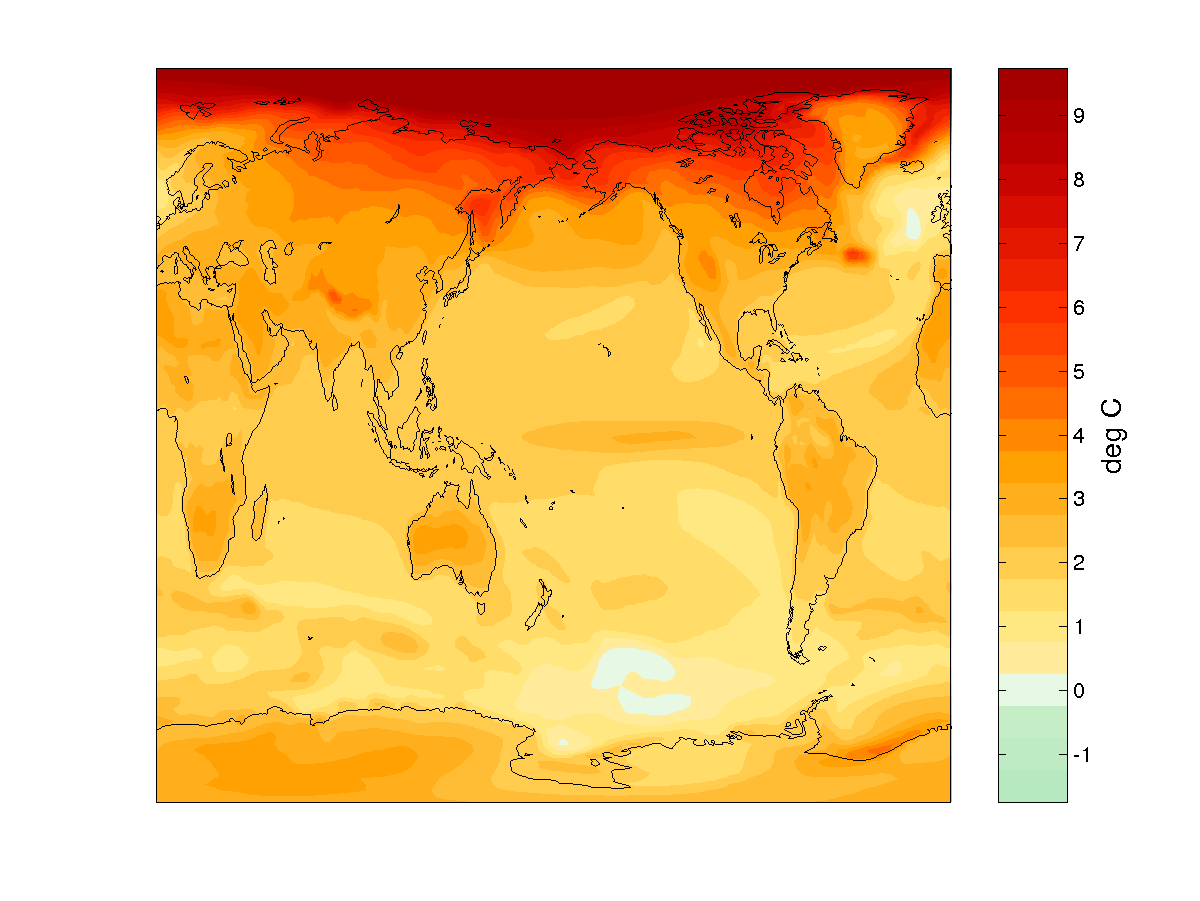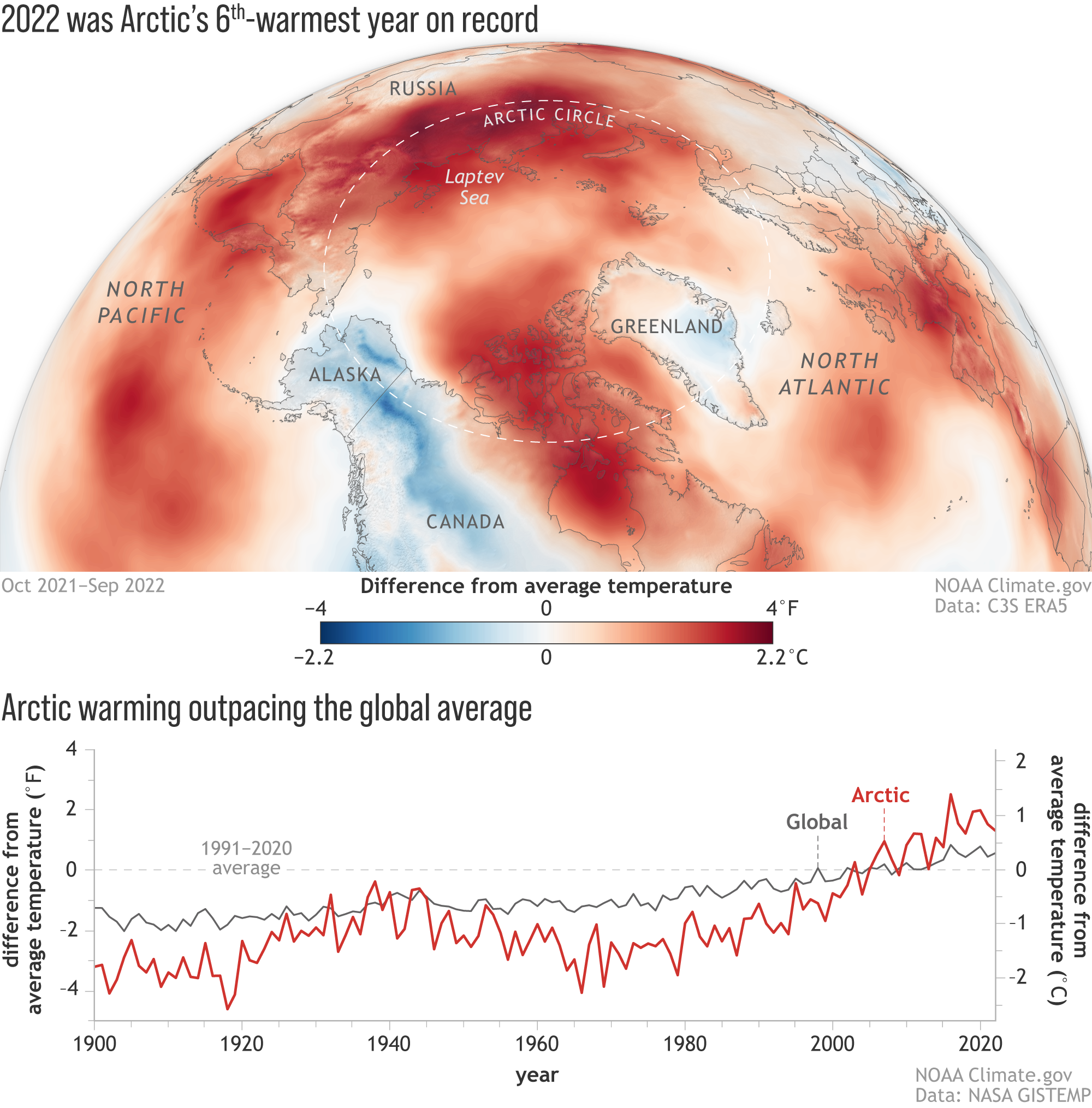Arctic/Polar Amplification Effect
The Arctic/Polar Amplification Effect is mainly caused by a combination of a few things. The chief components include the magnitude of change regarding ice extent and snow cover loss allows for a more dramatic change in climate architecture of the polar region. This also relates to the amount of land in the northern hemisphere verses the southern hemisphere.
Arctic/Polar Amplification Effect
The amount of land in the norther hemisphere allows for greater potential for increases and decrease of snow cover. This fact allows for greater cooling and warming potentials when the overall climate forcing is altered. Less forcing would result in a cooling trend that would allow more snow cover and therefore a polar de-amplification effect in relation to the average temperature of the rest of the globe. More forcing allows for a more rapid decrease in snow and ice cover thus amplifying the temperature in the polar region.
If you click on the image on the right, you can see the expected Arctic amplification represented in surface warming trend in °C per century from NCAR CCSM3 averaged from 9 ensemble members using the SRES A1B scenario.
The Arctic amplification effect is not hard to understand. It contains several main components to consider to give you a good understanding of the effect. One is that the northern hemisphere (NH) is mostly land, which warms and cools very fast. The southern hemisphere (SH) is mostly water, which warms and cools very slowly. Also, in the Arctic and its surrounding regions, there is typically a lot of snow and ice.
In fact, typically, the Arctic ocean is mostly covered with what is called the polar ice cap. The ice and snow of the NH helps reflect sunlight back into space without converting it to long wave infrared, so that solar energy can not be trapped by greenhouse gases.
In a warming world, it is expected that the Arctic would heat faster for these reasons.
- Loss of the Arctic Ice cap in Summer melt season.
- The summer cooling effect of the ice cap will be lost.
- The resulting accelerating warming will increase the latitudinal shift of the jet-stream, thus drying out areas of land further to the north resulting in changes to vegetation and land albedo as well as increased fire risk (all of which translate to increased CO2 and increased warming). Dryer regions moving north will severely impact existing crop growth infrastructure.
- The polar ice is on the water, while the Antarctic ice is sitting on land. As the oceans warm, more warm water helps melt the Arctic ice. This can not happen at the south pole since it is sitting on land.
- Colder dense air over the Antarctic prevents some degree of mixing with air mass from other regions, thus helping this region retain cold air mass longer than the in Arctic region which is subject to many factors that can move heat or cold energy in and out of the polar region through the ocean or the atmosphere.
In the graph below, we can see the amplification effect represented in the difference in temperature increase between the northern hemisphere (NH) and southern hemisphere (SH) as indicated in the graph based on the work done at NASA/GISS.
Arctic Amplification
Source: NASA: GISS Analysis Graphs and Plots
Human vs. Natural Cause
It is important to understand that natural variation is always involved. Ocean cycles which move heat content vertically in the ocean system and latitudinally (north and south around the globe) as well as east and west currents. This heat transport is responsible for natural changes on fairly large scales. Science is working to differentiate the natural and the anthropogenic cause and effect relationships. The picture is becoming more clear. Better understanding of these interactions will yield stronger understanding of longer and shorter time scale influences on atmospheric temperatures.
Between 1880 and 1920
We can see that the hemispheres were in relative equilibrium. The industrial age had begun but the CO2 output was much smaller than our modern industrial output, and its affects were not yet overwhelming the natural variation or the oceans capacity to absorb CO2.
Between 1920 and 1945
We see the NH temperatures separate from the SH temperature trend. There was a lot of coal being burned then, and this is likely attributed to the Arctic Amplification effect.
Between 1945 and 1975
We see a reversal of the effect. One might be tempted to say then the Arctic amplification effect is wrong, but that would be a mistake. In fact, once you consider the atmospheric changes in that period we see even further evidence of the effect. After WWII, the composition of industrial output changes and massive amounts of reflective aerosols were put in to the atmosphere. These aerosols blanketed the NH with particulates that helped cool the earth. It is also likely that the ocean cycles are involved in the variation.
Since the NH is mostly land, which in a warming world that is out of balance with thermal equilibrium, the blanket of aerosols apparently provided a significant cooling capacity. This supports the general thesis similar to how the Mt. Pinatubo eruption helped confirm Global Circulation Models at NASA. The aerosols were not well mixed into the global atmosphere. By reflecting most of that sunlight back into space the NH was able to cool faster than the SH during that time period.
It was found that the levels and types of pollution were causing things such as acid rain and the depletion of the ozone layer. The Montreal Protocol was put in place in order to protect the human race from further destroying its capacity to grow food and protect the ozone layer which is critical for life on earth.
After the Montreal Protocol was put in place, much of the harmful aerosols were no longer produced. It was noticeably soon afterward that the adverse effects of acid rain and ozone depletion were reduced and reversed. The Arctic Amplification effect reversed again and in the span of 13 years, resumed its expected course with the NH warming faster than the SH. Without significant aerosol pollution in the NH the Arctic amplification is expected to continue to increase as global warming progresses.
Links
- https://data.giss.nasa.gov/gistemp/graphs/
- https://nsidc.org/monthlyhighlights/august2009.html
- https://earthobservatory.nasa.gov/Features/GISSTemperature/giss_temperature4.php
- https://www.realclimate.org/index.php/archives/2006/01/polar-amplification/
- https://www.the-cryosphere.net/3/11/2009/tc-3-11-2009.html
- Related content
- Arctic Ice Melt


